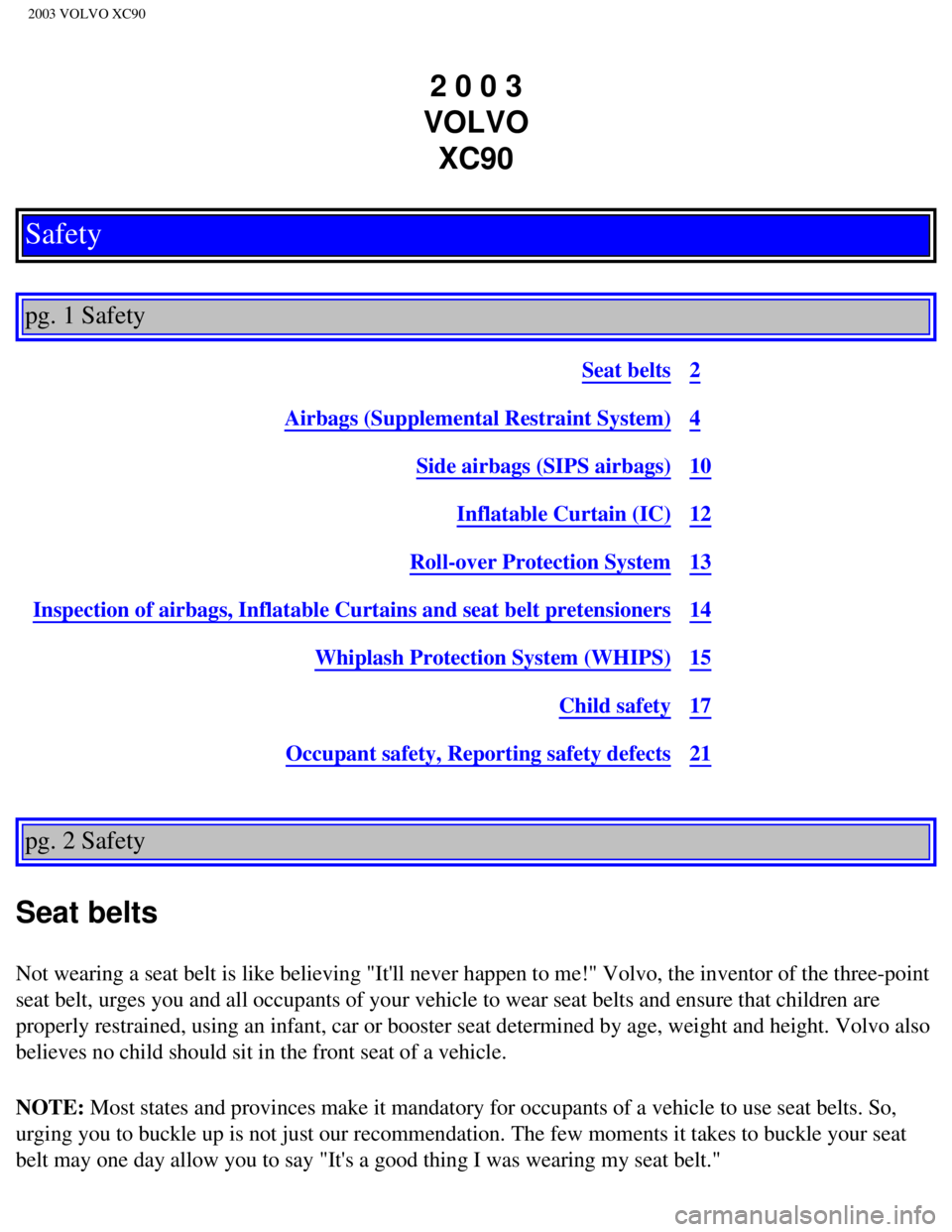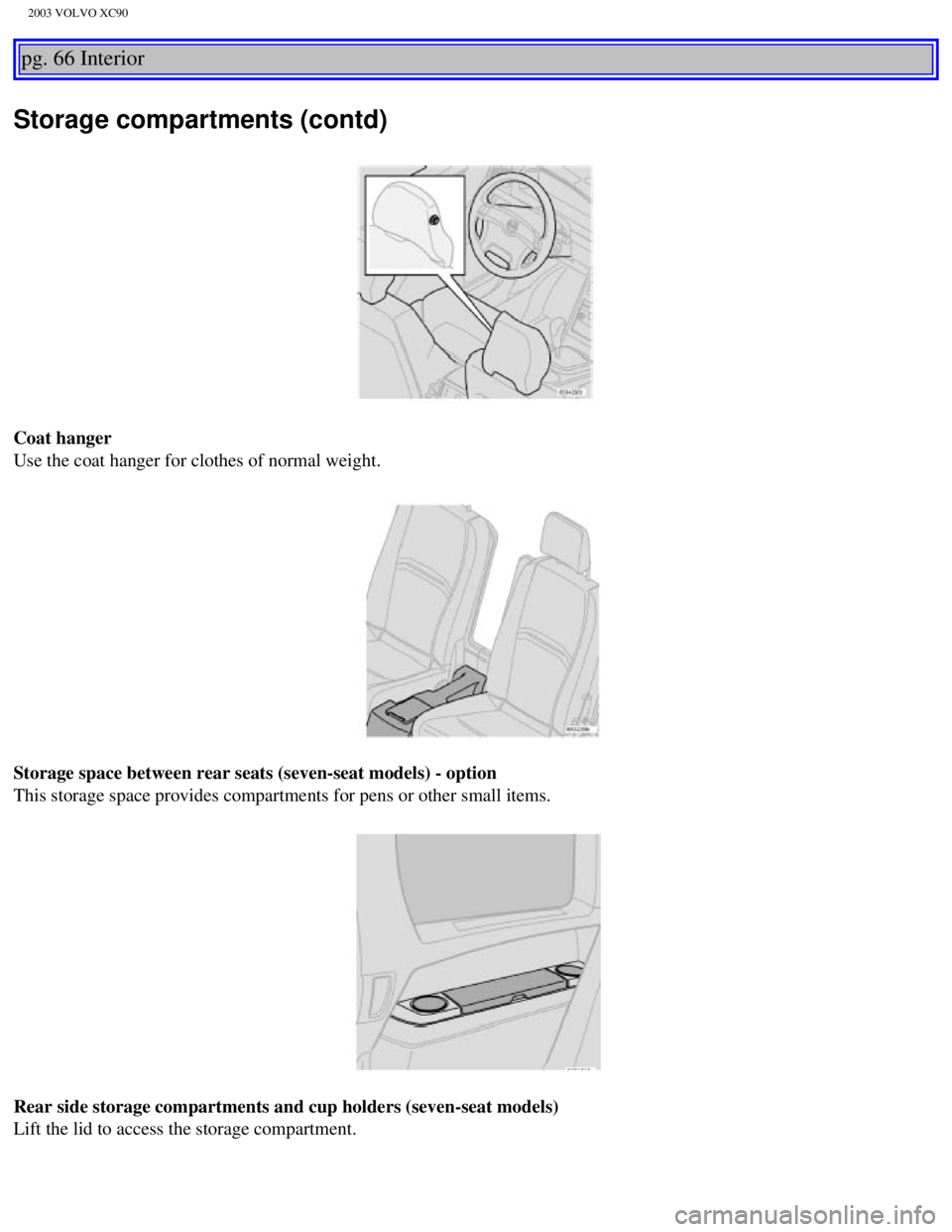2003 VOLVO XC90 weight
[x] Cancel search: weightPage 4 of 242

2003 VOLVO XC90
environmental impact.
Volvo's environmental activities are based on a holistic view, which mea\
ns we consider the overall
environmental impact of a product throughout its complete life cycle. In\
this context, design, production,
product use, and recycling are all important considerations.
In production, Volvo has partly or completely phased out several chemica\
ls including chlorofluorocarbons
(CFCs), lead chromates, naphtanates, asbestos, mercury and cadmium; an\
d reduced the amount of chemicals
used in our plants 50% since 1991.
Volvo was the first in the world to introduce into production a three-wa\
y catalytic converter with Lambda
Sond, now called oxygen sensor, in 1976. The current version of this hig\
hly efficient system reduces emissions
of harmful substances (CO, HC, NOx) from the exhaust pipe by approxima\
tely 95% and the search to eliminate
the remaining emissions continues. Volvo is the only automobile manufact\
urer to offer CFC-free retrofit kits
for the air conditioning system of all models as far back as the 1975 Vo\
lvo 240. Advanced electronic engine
controls, refined purification systems and cleaner fuels are bringing us\
closer to our goal.
After Volvo vehicles and parts have fulfilled their use, recycling is th\
e next critical step in completing the life
cycle. The metal content is about 75% of the total weight of a vehicle, \
which makes the vehicle among the most
recycled industrial products. In order to have efficient and well contro\
lled recycling, many Volvo variants have
printed dismantling manuals, indicating the weight and material of indiv\
idual components. For Volvo, all
homogeneous plastic parts weighing more than 1.7 oz. (50 grams) are ma\
rked with international symbols that
indicate how the component is to be sorted for recycling.
In addition to continuous environmental refinement of conventional gasol\
ine-powered internal combustion
engines, Volvo is actively looking at advanced technology alternative-fu\
el vehicles.
When you drive a Volvo, you become our partner in the work to lessen the\
car's impact on the environment.
To reduce your vehicle's environmental impact, you can:
l Maintain proper air pressure in your tires. Tests have shown decreased f\
uel economy with improperly
inflated tires.
l Follow the recommended maintenance schedule in your Warranty and Service\
Records Information booklet.
l Drive at a constant speed.
l See an authorized Volvo retailer as soon as possible for inspection if t\
he check engine (malfunction
indicator) lamp illuminates, or stays on after the vehicle has started.\
l Properly dispose of any vehicle-related waste such as used motor oil, us\
ed batteries, brake pads, etc.
l When cleaning your car, use Volvo's own car care products, all of which \
have systematically been adapted to
the environment.
For additional information regarding the environmental activities in whi\
ch Volvo Cars of North America, LLC.
and Volvo Car Corporation are involved, visit our Internet Home Page at:\
http://www.volvocars.com
file:///K|/ownersdocs/2003/2003_XC90/03xc90_00.htm (4 of 7)12/30/2006 \
4:18:48 PM
Page 8 of 242

2003 VOLVO XC90
2 0 0 3
VOLVO XC90
Safety
pg. 1 Safety
Seat belts2
Airbags (Supplemental Restraint System)4
Side airbags (SIPS airbags)10
Inflatable Curtain (IC)12
Roll-over Protection System13
Inspection of airbags, Inflatable Curtains and seat belt pretensioners14
Whiplash Protection System (WHIPS)15
Child safety17
Occupant safety, Reporting safety defects21
pg. 2 Safety
Seat belts
Not wearing a seat belt is like believing "It'll never happen to me!" Vo\
lvo, the inventor of the three-point
seat belt, urges you and all occupants of your vehicle to wear seat belt\
s and ensure that children are
properly restrained, using an infant, car or booster seat determined by \
age, weight and height. Volvo also
believes no child should sit in the front seat of a vehicle.
NOTE: Most states and provinces make it mandatory for occupants of a vehicle \
to use seat belts. So,
urging you to buckle up is not just our recommendation. The few moments \
it takes to buckle your seat
belt may one day allow you to say "It's a good thing I was wearing my se\
at belt."
file:///K|/ownersdocs/2003/2003_XC90/03xc90_01a.htm (1 of 12)12/30/200\
6 4:18:49 PM
Page 27 of 242

2003 VOLVO XC90
that, regardless of age and size, a child should always be properly rest\
rained in a vehicle.
Your vehicle is also equipped with ISOFIX attachments, which make it mor\
e convenient to install child
seats (see
page 18).
Restraint systems for children are designed to be secured in the vehicle\
by lap belts or the lap portion of
a lap-shoulder belt. Such child restraint systems can help protect child\
ren in vehicles in the event of an
accident only if they are used properly. However, children could be enda\
ngered in a crash if the child
restraints are not properly secured in the vehicle. Failure to follow th\
e installation instructions for your
child restraint can result in your child striking the vehicle's interior\
in a sudden stop.
Holding a child in your arms is NOT a suitable substitute for a child re\
straint system. In an accident, a
child held in a person's arms can be crushed between the vehicle's inter\
ior and an unrestrained person.
The child could also be injured by striking the interior, or by being ej\
ected from the vehicle during a
sudden maneuver or impact. The same can also happen if the infant or chi\
ld rides unrestrained on the
seat. Other occupants should also be properly restrained to help reduce \
the chance of injuring or
increasing the injury of a child. All states and provinces have legislat\
ion governing how and where
children should be carried in a vehicle. Find out the regulations existi\
ng in your state or province. Recent
accident statistics have shown that children are safer in rear seating p\
ositions than front seating positions
when properly restrained. A child restraint system can help protect a ch\
ild in a vehicle. Here's what to
look for when selecting a child restraint system:
l It should have a label certifying that it meets applicable Federal Motor\
Vehicle Safety Standards
(FMVSS 213) - or in Canada, CMVSS 213.
l Make sure the child restraint system is approved for the child's height,\
weight and development - the
label required by the standard or regulation, or instructions for infant\
restraints, typically provide this
information.
l In using any child restraint system, we urge you to carefully look over \
the instructions that are
provided with the restraint. Be sure you understand them and can use the\
device properly and safely in
this vehicle. A misused child restraint system can result in increased i\
njuries for both the infant or child
and other occupants in the vehicle.
When a child has outgrown the child safety seat, you should use the rear\
seat with the standard seat belt
fastened. The best way to help protect the child here is to place the ch\
ild on a cushion so that the seat
belt is properly located on the hips (see
page 2). Legislation in your state or province may mandate the
use of a child seat or cushion in combination with the seat belt, depend\
ing on the child's age and/or size.
Please check local regulations.
A specially designed and tested booster cushion (not available in Canad\
a) for children between the age
of 3 and approximately 10 years, weighing 33-80 lb (15-36 kg) and 38-5\
4 inches (97-137 cm) in height,
can be obtained from your Volvo retailer.
file:///K|/ownersdocs/2003/2003_XC90/03xc90_01b.htm (8 of 15)12/30/200\
6 4:18:50 PM
Page 86 of 242

2003 VOLVO XC90
pg. 66 Interior
Storage compartments (contd)
Coat hanger
Use the coat hanger for clothes of normal weight.
Storage space between rear seats (seven-seat models) - option
This storage space provides compartments for pens or other small items. \
Rear side storage compartments and cup holders (seven-seat models)
Lift the lid to access the storage compartment.
file:///K|/ownersdocs/2003/2003_XC90/03xc90_04b.htm (4 of 10)12/30/200\
6 4:18:55 PM
Page 112 of 242

2003 VOLVO XC90
Weight distribution affects handling
At the specified curb weight your vehicle has a tendency to understeer, \
which means that the steering
wheel has to be turned more than might seem appropriate for the curvatur\
e of a bend. This ensures good
stability and reduces the risk of rear wheel skid. Remember that these p\
roperties can alter with the
vehicle load. The heavier the load in the cargo area, the less the tende\
ncy to understeer.
WARNING!
Driving with the tailgate open: Driving with the tailgate open could lead to poisonous exhaust gases
entering the passenger compartment. If the tailgate must be kept open fo\
r any reason, proceed as
follows
- Close the windows
- Set the ventilation system control to air flow to floor, windshield an\
d side windows and blower
control to its highest setting.
CAUTION
Drive slowly and carefully if going through standing water (i.e. floode\
d roadways, etc.). Damage to
the engine could result if excess water is drawn in through the air inta\
ke system. Never drive the
vehicle in water deeper than 18 inches (48 cm).
pg. 90 Starting and driving
General information (contd)
Handling, roadholding
Vehicle load, tire design and inflation pressure all affect vehicle hand\
ling. Therefore, check that the tires
are inflated to the recommended pressure according to the vehicle load. \
See "Tire pressure" section.
Loads should be distributed so that capacity weight or maximum permissib\
le axle loads are not exceeded.
Driving on rough/unpaved surfaces
The Volvo XC90 is designed primarily for onroad driving, and it has exce\
llent handling characteristics
on very rough or unpaved roads.
When driving on poorly maintained or unpaved roads, please keep the foll\
owing in mind:
l Reduce speed on rough surfaces to minimize possible damage to the vehicl\
e's underbody.
l When driving on soft surfaces such as dry sand or snow, try to avoid sto\
pping if at all possible.
file:///K|/ownersdocs/2003/2003_XC90/03xc90_06a.htm (9 of 15)12/30/200\
6 4:18:58 PM
Page 129 of 242

2003 VOLVO XC90
pg. 103 Starting and driving
Towing a trailer
Volvo recommends the use of Volvo trailer hitches that are specially des\
igned for the vehicle.
l Maximum trailer weights recommended by Volvo are:
All models - trailers without brakes: 1,650 lbs (750 kg)
Models with all wheel drive - trailers with brakes: 4,960 lbs (2250 kg)\
Models with front wheel drive - trailers with brakes: 3,970 lbs (1800 k\
g)
Observe the legal requirements of the state/province in which the vehicl\
es are registered.
l All Volvo models are equipped with energy-absorbing shock-mounted bumper\
s. Trailer hitch
installation should not interfere with the proper operation of this bump\
er system.
Trailer towing does not normally present any particular problems, but ta\
ke into consideration:
l Increase tire pressure to recommended full. See section "Wheels and tire\
s."
l When your vehicle is new, avoid towing heavy trailers during the first 6\
20 miles (1,000 km).
l Recommended hitch tongue load is: Trailer weights below 2,650 lbs (1,200 kg) - 110 lbs (50 kg)
Trailer weights above 2,650 lbs (1,200 kg) - 198 lbs (90 kg)
l Maximum speed when towing a trailer: 50 mph (80 km/h).
l Engine and transmission are subject to increased loads. Therefore, engin\
e coolant temperature should
be closely watched when driving in hot climates or hilly terrain. Use a \
lower gear and turn off the air
conditioner if the temperature gauge needle enters the red range.
l If the automatic transmission begins to overheat, a message will be disp\
layed in the text window.
l Avoid overload and other abusive operation.
l Hauling a trailer affects handling, durability, and economy.
l It is necessary to balance trailer brakes with the towing vehicle brakes\
to provide a safe stop (check
and observe state/local regulations).
l Do not connect the trailer's brake system directly to the vehicle's brak\
e system.
l More frequent vehicle maintenance is required.
l Remove the ball and drawbar assembly when the hitch is not being used.
l Volvo recommends the use of synthetic engine oil when towing a trailer o\
ver long distances or in
mountainous areas.
file:///K|/ownersdocs/2003/2003_XC90/03xc90_06b.htm (11 of 17)12/30/20\
06 4:18:59 PM
Page 130 of 242

2003 VOLVO XC90
WARNING!
Bumper-attached trailer hitches must not be used on Volvos, nor should s\
afety chains be attached to
the bumper.
Trailer hitches attaching to the vehicle rear axle must not be used.
Never connect a trailer's hydraulic brake system directly to the vehicle\
brake system, nor a trailer's
lighting system directly to the vehicle lighting system. Consult your ne\
arest authorized Volvo retailer
for correct installation.
When towing a trailer, the trailer's safety wire must be correctly faste\
ned to the hole or hook provided
in the trailer hitch on the vehicle. The safety wire should never be fas\
tened to or wound around the
drawbar ball.
pg. 104 Starting and driving
Towing a trailer (contd)
NOTE!
- When parking the vehicle with a trailer on a hill, apply the parking b\
rake before putting the gear
selector in (P)ark. When starting on a hill, put the gear selector in \
(D)rive before releasing the parking
brake.
- If you use the manual (Geartronic) shift positions while towing a tr\
ailer, make sure the gear you select
does not put too much strain on the engine (using too high a gear).
- The drawbar assembly/trailer hitch may be rated for trailers heavier t\
han the vehicle is designed to tow.
Please adhere to Volvo's recommended trailer weights.
Leveling
If your vehicle is equipped with automatic levelling, the rear suspensio\
n always retains the correct ride
height regardless of the load. When the vehicle is stationary, the rear \
suspension lowers, which is
normal.
pg. 105 Starting and driving
Detachable trailer hitch - installing/removing
file:///K|/ownersdocs/2003/2003_XC90/03xc90_06b.htm (12 of 17)12/30/20\
06 4:18:59 PM
Page 152 of 242

2003 VOLVO XC90
l Lift the wheel and place it on the hub.
l Install the wheel bolts and tighten handtight. Using the lug wrench, tig\
hten crosswise until all bolts
are snug.
l Lower the vehicle to the ground and alternately tighten the bolts crossw\
ise to 102 ft. lbs. (140 Nm).
l Install the wheel cap (where applicable).
WARNING!
- The jack must correctly engage the bar in the jack attachment. The veh\
icle's weight must not rest on
the jack attachment. See illustration "Attaching the jack" above. Be sure the jack is on a firm, level,
non-slippery surface.
- Never allow any part of your body to be extended under a vehicle suppo\
rted by a jack.
- Use the jack intended for the vehicle when replacing a wheel. For any \
other job, use stands to
support the side of the vehicle being worked on.
- Apply the parking brake and put the gear selector in the (P)ark position (or reverse on manual
transmissions).
- Block the wheels standing on the ground, use rigid wooden blocks or la\
rge stones. The jack should
be kept well-greased.
pg. 122 Wheels and tires
This page intentionally left blank
Contents | Top of Page
file:///K|/ownersdocs/2003/2003_XC90/03xc90_08.htm (12 of 12)12/30/200\
6 4:19:01 PM